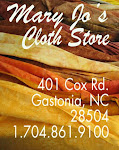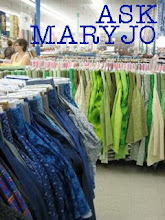Keeping Up with the Times
While we strive to maintain Mary Jo’s Cloth Store’s original values, we have changed with the times. In 1951, when Mary Jo first established her business in the back of her father’s grocery store, her clientele was mainly stay-at-home moms on a budget. Thomas Cloninger, Mary Jo’s son and current CEO and CFO says, “She kept her markdown low to keep it affordable.” Mary Jo never advertised. She would say “It isn’t good money sense… That money could buy fabric and give customers a second or third selection instead.” And, adds Thomas, “she never looked at a balance sheet.” However, with the fall of the textile industry and a loss of interest in the sewing community in general (think of making clothing versus back-to-school shopping) we’ve had to alter this part of Mary Jo’s business plan. Of course, our biggest concern is keeping our prices low, our inventory high and our customers happy, but bringing in new customers and letting people know what we have to offer is now more vital to our business than it was 50 years ago.Today we work with a small, local marketing team who helps us gather new customers and stay connected with returning customers. They help us run our social media accounts, plan our major sales events and manage our website among a list of other things that help us stay connected. While Mary Jo might have never considered a luxury like a website herself, we understand that it is crucial to our business. Our online orders span the entire globe – something we could have never done with the physical store alone. But, don’t worry about us getting too crazy; we stick to a plethora of Mary Jo’s original wishes, like our handmade signs that still adorn the store. Take for instance the one that hangs above the checkout counter - “Mary Jo's will always be open to serve our customers” – that’s something that will never change.
Same Family Business; Same Ideas and Service
Mary Jo has retired, but we still honor the characteristics of a family business. Several of Mary Jo’s direct family members remain strongholds of the Mary Jo team. But, Mary Jo never worried about selling out. Instead, she fretted about selection, pleasing her customers and making sure that her store lived up to its reputation. At the end of the day, she believed that the future would never be a problem and that everything would take care of itself. While Mary Jo could have gone nationwide early in her career, she would say, “I belong to no one. I run an independent business as I see fit. I am the exception to the norm… I am asked every day to open up a new store… I will not, because if you can’t do it well, don’t do it – and I can’t be in three or five places at once.”Mary Jo’s has succeeded because we don’t follow the usual level of retail markups. We have a lower overhead, and we attribute our success to the tremendous values we pass along to our customers. We offer a better value than most of the competition because of our huge volume, but the secret is that we truly care about our customers. We try our best to make their trip worthwhile, because people are taking time out of their day, sometimes even traveling, to get here. We try to make it an exciting trip.
Changes in the Industry
Just a few decades ago, future brides and their families would come to Mary Jo’s for one intense shopping spree. During the spree, they would buy everything necessary to make each of their dresses and turn themselves out as an ensemble by virtue of their coordinating clothing. Today, the bridal inventory is much smaller - an index to the fabric business at large. Fabric that used to come in quantities of 2,000 yards or more, are now reduced to as few as 500 yards. Large quantities of fabric must be requested months in advance, and chances are it’s “one run and done.” No manufacturer wants to be sitting on thousands, or even hundreds, of unsold yards of fabric.Despite the shifting conditions, Mary Jo’s has continued to thrive as one of the only one-stop suppliers in the nation to designers of theater productions, films, quilting fests and sumptuously appointed homes. “She was the first big-box store in the industry,” says Thomas concerning his mother’s enterprise. As more garment manufacturing moves overseas, fewer leftover bolts of fabric, called “off goods,” are available to fabric retailers in the United States. Less selection hurts independent stores like us who built their reputation on having the widest selection around. While in the past we might try to keep 15 shades of denim on the shelves, that’s just not possible if manufacturers cut back to only seven shades. Today only enough goods are made to fill orders – nothing extra like in the past.







No comments:
Post a Comment